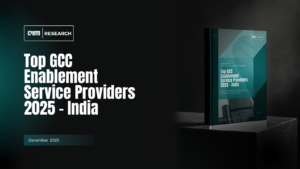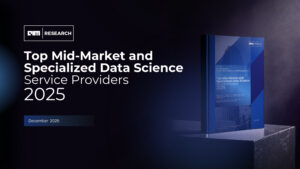The integration of coding assistants into organizational workflows marks a transformative shift, enhancing efficiency and fostering innovation in the digital era. These AI-driven tools are revolutionizing software development and data analysis, providing unparalleled support in coding tasks, problem-solving, and process optimization. Leveraging the capabilities of coding assistants enables businesses to streamline operations and unlock new avenues for creativity and strategic thinking. This approach positions organizations at the forefront of technological advancement, ensuring competitiveness and adaptability in the rapidly evolving digital landscape.
We had a roundtable discussion on the topic with a set of experienced and distinguished leaders in the industry. The session was moderated by Kashyap Raibagi, Associate Director – Growth at AIM along with panelists Deepak Jose, Global Head and Senior Director for One Demand Data and Analytics Solutions at Mars, Chiara Piccinotti, (EX) VP of Commerce Product & Monetization Data Science at Twitch, Amazon, Sanyam Kumar, Associate Director, Data Science at Genmab, Mandy Plante, Senior Data & Analytics Leader and Srini Tanikella, CIO/Vice President, Information Technology at SGH – SMART Global Holdings.
Leveraging AI Capabilities Across Organizational Functions
My team at Mars is committed to responsibly using AI. We are working with NGOs like the Responsible AI Institute and big tech companies like Microsoft to develop our Responsible AI strategy to enhance our skills. There are four main areas where we are currently building capabilities. The first area is about knowledge synthesis, where we improve our skills by combining new LLM skills with existing tools. This will allow associates to interact with data like humans and help with adoption. The second area is linked to content and creativity. We use the LLMs for sales and marketing functions. This is an area where many organizations are beginning to use skills. The third area involves coding. We’re partnering closely with Technology partners to create a skill to optimize coding reusability. For instance, we’re using GitHub. The fourth area is focused on engagement: how we can engage better with our external consumers. We’re also exploring more skills like Microsoft Fabric, which can create a One Lake skill that can be very impactful in a multi-cloud environment with data silos. Although we’ve made progress and our data science teams are applying these skills, we think that we have a lot more to learn. We’re eager to continue our journey in using Technology responsibly and driving skill-building at Mars
– Deepak Jose, Global Head and Senior Director for One Demand Data and Analytics Solutions at Mars
Navigating the Blend of Innovation and Practical Application in Coding
It’s interesting to see the similarities and differences in our approaches. I find myself in a blend of various initiatives. We have comparable projects aimed at engaging our customers and improving their experiences.
However, my focus leans more towards the coding aspect, which can be divided into two main areas. The first area is code development. While there isn’t a formal integration into our development cycles or pipelines, developers are encouraged to explore and utilize new tools with certain guidelines, such as avoiding the use of proprietary or sensitive data. This environment fosters exploration, with a dedicated Slack channel where developers share findings, compare notes, and discuss what works or doesn’t. This open exploration encourages experimentation and informal learning among our teams.
The second area, which I mentioned revolves around our internally developed NLP capabilities and similar projects. We’re actively researching how to enhance the accuracy of these tools when applied to our internal data structures. The goal is to achieve a level of precision that allows these tools to provide correct, or at least close, answers.
Although it is early days, based on beta testing results, the team is optimistic. The effort to develop these tools for broader internal use, such as enabling business analysts or users to generate SQL queries, reflects our commitment to innovation and the practical application of these technologies within our organization.
– Mandy Plante, Senior Data & Analytics Leader
Evaluating the Drive for Custom Tech Against Collective Innovation
I’m somewhat skeptical about the effectiveness of adopting a formal and centralized approach to deploying AI coding assistants in engineering and data science teams. The AI field is evolving so rapidly that I think the best approach is grassroots experimentation, plus a touch of top-down risk mitigation.
It’s important to allow our engineers and data scientists the freedom to explore tools and share learnings organically. Initiatives like hackathons, dedicated communication channels, and peer-led workshops are excellent ways to promote this culture. At the same time, as leaders, we can establish some overarching guidelines to protect our intellectual property and ensure safety without stifling innovation. Over-regulating could hinder creativity rather than support it.
Looking to the future, I believe that specialized third-party tools will likely outperform anything that most companies could develop in-house. The rush to develop proprietary AI solutions without deep expertise is a little reminiscent of the early 2000s when brands hastily tried to launch their own social networks, often without clear strategic purpose. I think we can learn from that and invest more thoughtfully this time around.
– Chiara Piccinotti, (EX) VP of Commerce Product & Monetization Data Science at Twitch, Amazon
Advancing Recruitment and Innovation with AI Integration
The essence of our conversation highlights that traditional coding assessments, once a staple of interviews, could now be augmented or even replaced by AI agents. This approach not only streamlines the process but opens new avenues for evaluating candidates.
The emphasis on creativity within my organization transcends the allure of adopting AI for its novelty. Our goal is to harness AI’s capabilities to explore and solve use cases previously out of reach. For example, analyzing vast repositories of research papers on specific therapeutic areas or diseases over the last decade becomes feasible with advanced NLP and LLMs, amplifying our analytical capabilities beyond traditional methods.
However, this fast-paced evolution comes with its challenges, such as the phenomenon of AI “hallucination” and the inconsistent performance of newer models compared to their predecessors. The rapid deprecation and introduction of models highlight the unpredictable nature of AI development, where newer isn’t always synonymous with better.
This blend of traditional expertise and openness to novel approaches forms the cornerstone of our strategy in navigating the complexities and opportunities presented by AI.
– Sanyam Kumar, Associate Director, Data Science at Genmab
Rethinking Innovation Beyond Coding to Conceptual Understanding
Your reflection brings an important distinction to the forefront of the conversation about innovation and technology within organizations. It’s not merely about what a company needs to do in terms of adopting new technologies or practices; it’s fundamentally about how individuals within the company evolve their understanding of problems and solutions over time.
While it’s essential for creating software products, coding in isolation doesn’t equate to innovation. The true innovation lies in the ideation phase, where the conceptualization of a product takes place. It’s about identifying a need or a problem and then envisioning a solution that addresses it effectively. The coding process is what turns these ideas into tangible products, but the genesis of innovation is always in the idea itself, not the code.
Your personal experience of revisiting your own code and questioning its quality underscores a universal journey of growth and learning in the tech industry. Over time, as you gain more experience and a deeper understanding of the business and its challenges, your perspective on problem-solving evolves. This evolution leads to better code, not necessarily because your coding skills have improved, but because your comprehension of what needs to be achieved has deepened.
This brings us to the consideration of how software products evolve and how teams manage dependencies and interactions between different parts of a system. The question of whether code can become “smart” enough to suggest changes in other modules or adapt to new requirements is intriguing. It touches on the concept of self-documenting, self-refactoring code, or even AI-assisted development environments that can understand the broader context of the application being developed.
While current AI technologies and development tools offer some level of assistance—such as suggesting code improvements or identifying potential bugs—the idea of a fully autonomous system that can manage and refactor code across modules with a deep understanding of the product’s end goals remains a vision for the future. However, the rapid advancements in AI and machine learning technologies suggest that more intelligent and context-aware development tools could become a reality, further blurring the lines between coding as a task and innovation as the ultimate goal.
–Srini Tanikella , CIO / Vice President, Information Technology at SGH – SMART Global Holdings





